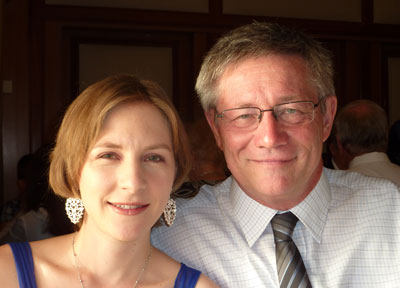The flood chaser
Tas Walker chats with fluvial geomorphologist Dr Ron Neller

Dr Neller holds a B.A. (Hons), and a Ph.D. in fluvial geomorphology, one of the Earth sciences. Geomorphology (geo = earth; morph = shape) is the study of the surface features of the earth, such as the landscapes on the continents and the landforms under the oceans; ‘fluvial’ (Latin fluere = to flow) relates to rivers. He has held lecturing and research positions at four universities in Australia, as well as universities in Finland and Hong Kong. Ron has initiated and directed a research institute in environmental sustainability, and established two research stations in natural resource management. He has undertaken landscape studies in many places around the world, and held numerous advisory positions with Australian governments and international agencies such as the OECD (Organisation for Economic Co-operation and Development).
Dr Ron Neller reflects that he has had an amazing career. “I’ve travelled the world. I’ve seen incredible river systems and incredible landscapes. I’ve experienced a diversity of cultures. I’ve also been robbed. I’ve been shot at. I’ve been arrested by foreign governments. I’ve been bitten by venomous creatures, I’ve fallen into raging rivers … and I’ve survived. It’s been an exciting life.”
The power of water
“I was essentially a flood chaser”, Ron says. “People enjoy movies about tracking and researching tornadoes, but I found floods more interesting. I saw an incredible variety of fluvial systems on this planet in a diversity of environments, including arctic, temperate, subtropical, tropical, and desert environments. In these travels I came to appreciate the power of water, and to understand the landscapes such systems created.”
Raised as one of four children in what he says was a dysfunctional family, Ron explained that he saw education as an escape mechanism. “Although I did not get the best of school grades to go to university I pleaded with my parents to let me go nonetheless—I would pay my own way. They did so, thinking that I was seeking education. But I was seeking to escape from life’s problems.”
“Don’t get me wrong. I loved my parents. In the years before they died I had a wonderful relationship with them. But in those earlier times it was difficult. So, when I stepped onto the stage of life I was not interested in a ‘father God’. I was trying to escape my own family.”
After he had completed his Ph.D., Ron set out to see the world. Over the years he’s carried out research in many countries, including Australia, Finland, various Pacific Island nations, South Africa, China, Peru, and Libya.


On returning to Australia with his many years of experience, Ron rose quickly through the ranks. He was appointed director of a research institute aligned with over 40 researchers. He set up a field research station on Fraser Island near Brisbane, Australia. It’s the world’s largest sand island, with an area of 1,840 km2 (710 sq. miles), and is World Heritage listed. Local research students joined others from overseas universities and worked on projects at the centre. As his reputation spread, he became an adviser to state and federal governments, dealing with World Heritage sites.
As Ron travelled the world, he says, “I was amazed by the diversity of environments on our planet. In Genesis 1:31 we read, ‘God saw everything that he had made, and behold, it was very good.’ At that time I would have changed that around and said that I saw everything that was there, and it was very good. So, although I now appreciate that we live in a fallen world, I think I was developing a tiny bit of the love for creation the Lord was expressing there.”
With his wide experience, Ron began to see that the geological evidence collected during his research did not fit the slow-and-gradual thinking that permeates his profession. He tells a story: “I was once researching in the Amazon jungle and my colleagues back home were theorizing how a changing climate formed the landscape over millions of years. But when I looked at the evidence I did not see that. What we saw were very mobile river systems rapidly changing their courses, and creating new landscapes that do not need eons of time. Why do we need to say it took many years? But, of course, I was told in no uncertain terms by some colleagues to think more ‘logically’.”
Peer pressure vs. evidence

Sometime later, Ron, not yet a Christian, was with a research team examining continental shelf sediments off Hong Kong. He says, “After we had analyzed the sediments in the laboratories, I looked at the data and said to university colleagues, ‘I see evidence in these ocean sediments for one flood, one enormous flood.’ Of course, I was again told to be ‘logical’, otherwise I could lose research grants.”
In all the time that Ron was travelling around the world, family, friends and colleagues would invite him to church. And he would go. “I could give you a list of the churches that I went to”, says Ron. “I don’t know what I was looking for, but I wasn’t consciously trying to connect with God. I was into my early fifties before I came to accept Jesus Christ and to finally give my life to Him.” It was only upon becoming a Christian that the geomorphological data he had gathered from decades of research finally started to make sense.
One issue that Ron faced when he became a Christian involved the age of the earth. According to the Bible, the earth’s age is about 6,000 years, but mainstream geologists work with ages of hundreds of millions of years. Asked about this, Ron explained that all dating methods are based on assumptions. He said that no one knows if these assumptions are valid or not. Recognizing those assumptions has for Ron destroyed any idea that radioactive dating, for instance, is a challenge to the biblical timeline. He illustrated with a simple example of water dripping into a cylinder (diagram above). Ron indicated that he had no problem with the biblical date of 6,000 years for the earth and the universe, and 4,500 years for the date of Noah’s Flood.
A related issue Ron mentioned concerns how most people think that scientists accept the results of radioactive dating without question. “They do not”, Ron said. “Large numbers of dates are rejected as being ‘contaminated’. Why? Because the dates do not match the age they already believe about that particular environment. But they do not report it that way.”
He gave one example from his experience when he was a research director at a camp on Fraser Island. Ron explained that there had been at least six dates obtained using carbon dating, but four of them were rejected as being ‘contaminated’. Ron argues, however, that they were rejected because they were too young—they indicated that the island was only thousands of years old.
Ron’s academic strength lies in understanding erosion, sediment transport and sediment deposition, and he found that he was unable to align his deep understanding of these with the orthodox geological belief about the process of fossilization. He argues that “Fossils are a record of death and catastrophic burial. These are clearly consistent with what we would expect from Noah’s Flood.”
Fossils not from river floods
Ron states that although fossils can be formed by a variety of processes, by far the majority of land-based plants and animals that have been fossilized were rapidly and deeply buried by sediments in an aquatic environment. To ensure fossilization, an organism must be buried deep enough to protect it from predation and to minimize decomposition by bacteria and chemicals.
“50-plus years of monitoring of rivers globally”, says Ron, “shows there is not enough sediment produced to create the large regional fossil beds that we see. There are many journal papers about sediment deposition from large floods today. They report only centimetres of sediment, and only over local areas. But metres of sediment are needed over extensive areas to fossilize even a small animal.”

When Ron eventually came to Christ, it was because, in his life’s journey, he was seeing Creation and the Genesis Flood in the landscapes. He says, “When I finally got around to looking at the Bible I thought, ‘Wow, there is such an amazing harmony between the landscapes and the account of Scripture’.” Ron is thankful that the Lord’s presence is so obvious. As the Apostle Paul notes, “For since the creation of the world His invisible attributes are clearly seen, being understood by the things that are made, even His eternal power and Godhead, so that they are without excuse” (Romans 1:20). Ron is also thankful that the Lord, who is great in power, is also slow to anger and wonderfully patient with all whom He loves.
Some eight years ago Ron left the university he was at because he wanted to research and write about the connection between geomorphology and the Bible. He is now part of the Creation Ministries International (CMI) team in Brisbane, where he is a researcher, writer and speaker whose articles are now appearing in Creation magazine, the Journal of Creation, and online on creation.com.
Re-posted on homepage: 12 December 2023


Readers’ comments
Comments are automatically closed 14 days after publication.